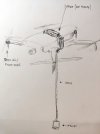Hello.
I am working on a project for a magnetic picking and dropping device.
My idea is to use a permanent magnet (neodymium or similar) that grabs stuff coupled to an electromagnet, thus a brief pulse of current will be enough to drop anything attached to it.
the magnet should have an attraction force slightly less or equal about to the maximum lifting capacity of the drone (1kg for the mavic 2), in order to release the payload by itself if it gets stuck somewhere.
and it should dangle from its support about 1.5 meters from the drone, (then leghts can vary), just far enough not to interfere with its compass/magnetometer, using the red and black paired cable as the wire to sustain magnet and payload, it has the benefit not to twist or spin while posing the payload. (assume you are placing down a gopro for example, you wont curse too much to place it in the right direction)
All the payload should have is a small metallic plate the size of the magnet for it stick into.
Compared to the actual dropper it shoud be smaller, lighter (about 35 grams on mavic 2) and easier to build: mangnet, wire, battery, a strap as support (or something "cooler" 3d printed) and the photocell/photodiode to command it (mavic 2 has no other ways to operate it) are all its required.
And safer: it offers a better way to pick up stuffs minimizing the risk of getting stuck, unlike hooks.
What do you think about, is it feasable?
What kind of magnet do i need?
I am working on a project for a magnetic picking and dropping device.
My idea is to use a permanent magnet (neodymium or similar) that grabs stuff coupled to an electromagnet, thus a brief pulse of current will be enough to drop anything attached to it.
the magnet should have an attraction force slightly less or equal about to the maximum lifting capacity of the drone (1kg for the mavic 2), in order to release the payload by itself if it gets stuck somewhere.
and it should dangle from its support about 1.5 meters from the drone, (then leghts can vary), just far enough not to interfere with its compass/magnetometer, using the red and black paired cable as the wire to sustain magnet and payload, it has the benefit not to twist or spin while posing the payload. (assume you are placing down a gopro for example, you wont curse too much to place it in the right direction)
All the payload should have is a small metallic plate the size of the magnet for it stick into.
Compared to the actual dropper it shoud be smaller, lighter (about 35 grams on mavic 2) and easier to build: mangnet, wire, battery, a strap as support (or something "cooler" 3d printed) and the photocell/photodiode to command it (mavic 2 has no other ways to operate it) are all its required.
And safer: it offers a better way to pick up stuffs minimizing the risk of getting stuck, unlike hooks.
What do you think about, is it feasable?
What kind of magnet do i need?
Last edited:












